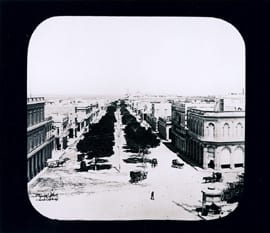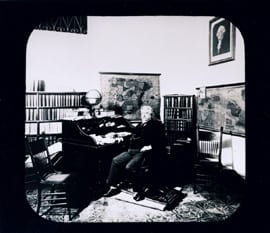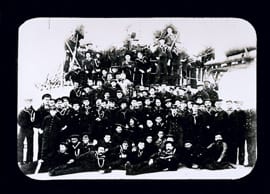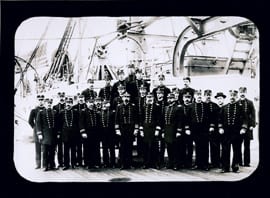
- This event has passed.
ONCE UPON A TIME IN HAVANA HARBOR: THE USS MAINE
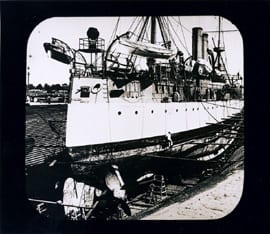
| Curated by Patricia McAndrew
A small-scale exhibition of vintage prints made from glass lantern slides of the 1890s, showing scenes of Cuba and the battleship Maine, and those who manned her. Included are ship’s artifacts from the Robert Sayre collection. Originally designed as a cruiser, the Maine eventually went to sea as a battleship, second class, and was the first of a line of steel-hulled, steam-powered battleships for the U.S. Navy. Commissioned in 1895, she was built in the Brooklyn Navy Yard of steel armor made in Bethlehem, PA. The cause of the explosion that destroyed the Maine in Havana Harbor is still unknown. The U.S. subsequently went to war against Spain, and the cry “Remember the Maine ” resounded throughout the press and the battlefield. Curator’s Statement In Spring 2003, artist Steve Tobin presented Lehigh University Art Galleries Director, Ricardo Viera, with a old brown box filled with glass lantern slides showing Cuba, splendid warships, and scenes and personalities from the Spanish-American War. Knowing that the Cuban-born director had long been fascinated with Latin-American history and art, Tobin suggested that some of the vintage slides might furnish material for an exhibition. At the time, I happened to be doing some work on post-Civil War America, and Professor Viera asked me to take a look at the pictures and see if I could put something together. This small-scale exhibition is built around a series of photographic prints made from twelve of the old glass slides. Through them we get a glimpse of the new American Navy when the country stood on the threshold of international prominence. In 1895, after years of fighting unsuccessfully to free themselves from Spanish rule, Cuban insurgents launched a new rebellion. To avoid trouble, visits to Cuba by U.S. naval vessels were suspended. Many Americans were strongly sympathetic to the Cubans’ freedom fight. President William McKinley, though upset by the Cubans’ plight, believed that the situation could be resolved through diplomacy and negotiation. When serious rioting broke out in early 1898, the U. S. consul felt–perhaps prematurely– that it would be helpful for an American ship to once again “show the flag” in Cuban waters. That ship happened to be the USS Maine. Though anti-American rumors abounded during her three-week stay, the white ship almost completed her “friendly” visit. She was expecting to leave soon for New Orleans, but on the night of February 15, 1898, a violent explosion destroyed most of the forward portion of the ship and the lives of the majority of her crew members along with it. The tragedy was greeted with cries of outrage from most Americans. “Remember the Maine!” became a rallying cry. Legacy of the MAINE On February 16, 1898, as people throughout the United States were learning details of the naval tragedy, the astute young Assistant Secretary of the Navy, Theodore Roosevelt, wrote to his superior, “It may be impossible to ever settle definitely whether or not the Maine was destroyed through some treachery . . . .” And how right he was! Almost from the outset, there were plenty of theories concerning the fate of the Maine.Whatever the truth of the matter, the USS Maine,like the Alamo, quickly became a legend. By the time the Maine was raised from her watery grave in 1911, people were clamoring for mementos. Salvaged pieces of metal and artifacts were sent to communities all over the United States. The explosion of the Maine, of course, had larger implications for the country’s future. It affected our international outlook and helped to redefine our national goals. Even the ship’s Captain, Charles Sigsbee, realized early on that the passing of the torch of empire from Old World Spain to brash young America brought with it profound responsibilities. And in the 1970s, when Admiral Rickover published the results of his study of the explosion, he cited the burden of scientific knowledge: “In the modern technological age, the battle cry ‘Remember the Maine’ should have a special meaning for us. With almost instanteneous communications that can command weapons of unprecedented power, we can no longer approach technical problems with the casualness and confidence held by Americans in 1898. The Maine should impress us that technical problems must be examined by competent and qualified people, and that the results of their investigation must be fully and fairly presented to their fellow citizens.” To my mind, however, Public Broadcasting said it best in its documentary, Remember the Maine: “As the end of the nineteenth century approached, the nation was growing more prosperous and more interested in world events. The Spanish-American war propelled the U.S. into the ranks of world powers, and its conclusion granted America territories in other parts of the globe. We became closely involved not only with Cuba, but also with the Philippines and Puerto Rico, among others. Those involvements came to have crucial significance to the United States during World War Two and the Cuban missile crisis. Fidel Castro, America’s battle against Communism, modern-era politics in this country, and even the ongoing question of statehood for Puerto Rico, are also ramifications of the incident which involved the U.S.S. Maine, and set the stage for America in the 20th century” –Patricia McAndrew |

